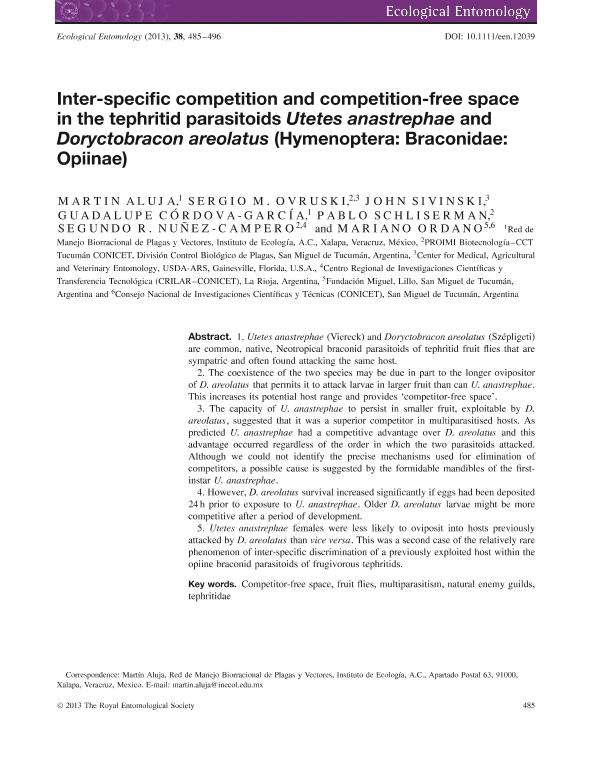Mostrar el registro sencillo del ítem
dc.contributor.author
Aluja, Martin
dc.contributor.author
Ovruski Alderete, Sergio Marcelo

dc.contributor.author
Sivinski, John
dc.contributor.author
Córdova García, Guadalupe
dc.contributor.author
Schliserman, Pablo

dc.contributor.author
Núñez Campero, Segundo Ricardo

dc.contributor.author
Ordano, Mariano Andrés

dc.date.available
2015-07-27T15:12:29Z
dc.date.issued
2013-05
dc.identifier.citation
Aluja, Martin; Ovruski Alderete, Sergio Marcelo; Sivinski, John; Córdova García, Guadalupe; Schliserman, Pablo; et al.; Inter-specific competition and competition-free space in the tephritid parasitoids Utetes anastrephae and Doryctobracon areolatus (Hymenoptera: Braconidae: Opiinae); Wiley Blackwell Publishing, Inc; Ecological Entomology; 38; 5; 5-2013; 485-496
dc.identifier.issn
0307-6946
dc.identifier.uri
http://hdl.handle.net/11336/1502
dc.description.abstract
Utetes anastrephae (Viereck) and Doryctobracon areolatus (Szépligeti) are common, native, Neotropical braconid parasitoids of tephritid fruit flies that are sympatric and often found attacking the same host. The coexistence of the two species may be due in part to the longer ovipositor of D. areolatus that permits it to attack larvae in larger fruit than can U. anastrephae. This increases its potential host range and provides 'competitor-free space'. The capacity of U. anastrephae to persist in smaller fruit, exploitable by D. areolatus, suggested that it was a superior competitor in multiparasitised hosts. As predicted U. anastrephae had a competitive advantage over D. areolatus and this advantage occurred regardless of the order in which the two parasitoids attacked. Although we could not identify the precise mechanisms used for elimination of competitors, a possible cause is suggested by the formidable mandibles of the first-instar U. anastrephae. However, D. areolatus survival increased significantly if eggs had been deposited 24h prior to exposure to U. anastrephae. Older D. areolatus larvae might be more competitive after a period of development. Utetes anastrephae females were less likely to oviposit into hosts previously attacked by D. areolatus than vice versa. This was a second case of the relatively rare phenomenon of inter-specific discrimination of a previously exploited host within the opiine braconid parasitoids of frugivorous tephritids.
dc.format
application/pdf
dc.language.iso
eng
dc.publisher
Wiley Blackwell Publishing, Inc

dc.rights
info:eu-repo/semantics/openAccess
dc.rights.uri
https://creativecommons.org/licenses/by-nc-sa/2.5/ar/
dc.subject
COMPETITOR-FREE SPACE
dc.subject
FRUIT FLIES
dc.subject
MULTIPARASITISM
dc.subject
NATURAL ENEMY GUILDS
dc.subject
TEPHRITIDAE
dc.subject.classification
Ecología

dc.subject.classification
Ciencias Biológicas

dc.subject.classification
CIENCIAS NATURALES Y EXACTAS

dc.title
Inter-specific competition and competition-free space in the tephritid parasitoids Utetes anastrephae and Doryctobracon areolatus (Hymenoptera: Braconidae: Opiinae)
dc.type
info:eu-repo/semantics/article
dc.type
info:ar-repo/semantics/artículo
dc.type
info:eu-repo/semantics/publishedVersion
dc.date.updated
2016-03-30 10:35:44.97925-03
dc.journal.volume
38
dc.journal.number
5
dc.journal.pagination
485-496
dc.journal.pais
Reino Unido

dc.journal.ciudad
Londres
dc.description.fil
Fil: Aluja, Martin. Instituto de Ecología; México
dc.description.fil
Fil: Ovruski Alderete, Sergio Marcelo. Consejo Nacional de Investigaciones Científicas y Técnicas. Centro Científico Tecnológico Conicet - Tucumán. Planta Piloto de Procesos Industriales Microbiológicos; Argentina
dc.description.fil
Fil: Sivinski, John. No especifíca;
dc.description.fil
Fil: Córdova García, Guadalupe. Instituto de Ecología; México
dc.description.fil
Fil: Schliserman, Pablo. Consejo Nacional de Investigaciones Científicas y Técnicas. Centro Científico Tecnológico Conicet - Tucumán. Planta Piloto de Procesos Industriales Microbiológicos; Argentina
dc.description.fil
Fil: Núñez Campero, Segundo Ricardo. Consejo Nacional de Investigaciones Científicas y Técnicas. Centro Científico Tecnológico Conicet - Tucumán. Planta Piloto de Procesos Industriales Microbiológicos; Argentina. Consejo Nacional de Investigaciones Científicas y Técnicas. Centro Regional de Investigaciones Científicas y Transferencia Tecnológica de La Rioja. - Universidad Nacional de La Rioja. Centro Regional de Investigaciones Científicas y Transferencia Tecnológica de La Rioja. - Universidad Nacional de Catamarca. Centro Regional de Investigaciones Científicas y Transferencia Tecnológica de La Rioja. - Secretaría de Industria y Minería. Servicio Geológico Minero Argentino. Centro Regional de Investigaciones Científicas y Transferencia Tecnológica de La Rioja. - Provincia de La Rioja. Centro Regional de Investigaciones Científicas y Transferencia Tecnológica de La Rioja; Argentina
dc.description.fil
Fil: Ordano, Mariano Andrés. Fund.Miguel Lillo; Argentina. Consejo Nacional de Investigaciones Científicas y Técnicas; Argentina
dc.journal.title
Ecological Entomology

dc.relation.alternativeid
info:eu-repo/semantics/altIdentifier/doi/http://dx.doi.org/10.1111/een.12039
Archivos asociados
